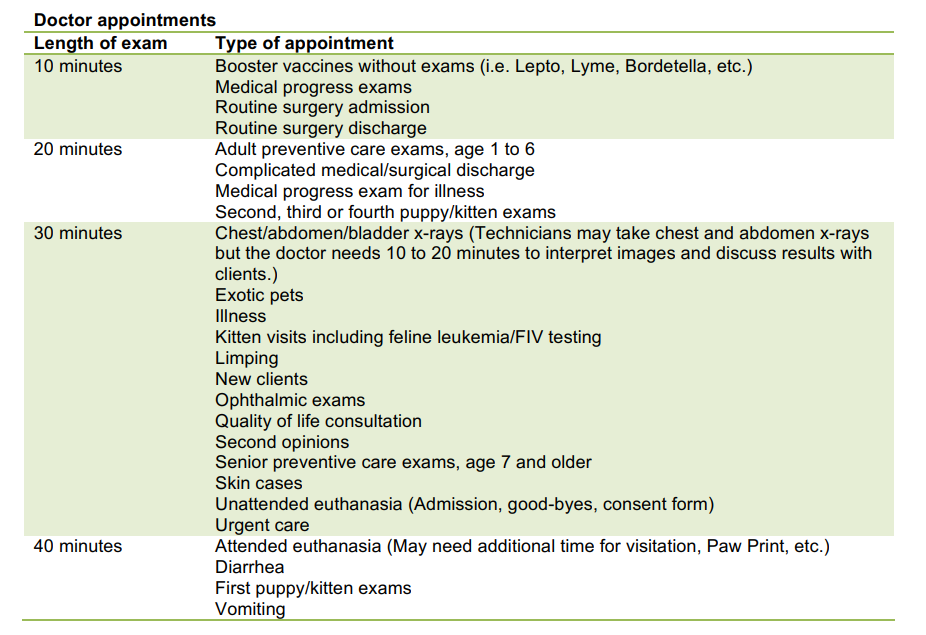Part
01
of one
Part
01
Veterinarian Practices Profitability Issues
Key Takeaways
- Veterinarians spend an estimated six hours a day seeing patients.
- The duration of a consult typically ranges from 10 to 20 minutes. However, this length can significantly increase depending on the chief complaint and whether it is a known patient or not.
- The COVID-19 pandemic has brought significant profitability challenges to veterinarian practices, including increased waiting times for clients and an unexpected increase in demand.
Introduction
Veterinarians spend most of their time in their practice examining patients and performing procedures. The length of a consult varies per patient, although the average duration can be estimated. Practices are facing different challenges that can affect their profitability. Therefore, a combination of both daily activities and profitability pain points has been provided.
Examining Known or Routine Patients
- According to the consulting company Communication Solutions for Veterinarians, veterinarians spend approximately six hours of the workday seeing patients.
- The estimated time for each patient is 20 minutes. A pain point observed in this context is that the medical history is often updated by the end of the day and details about the first patients might be forgotten.
- It is recommended that additional minutes be used to update the medical history of the patient after the examination.
- Delegating the record registry task as well as additional education about the treatment and other considerations is proposed as a good strategy to increase productivity.
- As a result, patient consults could be optimized to 10-15 minutes without endangering the quality of care.
Examining New Patients or Performing Procedures
- The duration of a consult varies according to the chief health complaint and whether the patient is known to the practice or not.
- When exams such as X-Rays are needed, the time during which the doctor interprets the test and explains the results to the owner can lead to a 30-minute consult.
- Similarly, dealing with an exotic animal, cats with leukemia, or that require feline immunodeficiency virus (FVI) testing will require consults of the same length.
- New patients, patients who require an ophthalmic exam, senior care exams, or who are limping will also require additional time.
- Patients who are vomiting or that are about to undergo attended euthanasia will require consults of about 40 minutes.
Staff Turnover
- The performance and efficiency of the practice can be heavily impacted by staffing issues. The turnover rate in this industry is usually twice the rate seen in other sectors.
- This constant turnover leads to reduced efficiency in the practice as new employees need to become familiar with the processes and the workflow.
- It has been reported that efficiency issues are common among 60% of veterinarian practices.
- According to surveys from the American Veterinary Medical Association (AVMA), 50-70% of practices are among the lowest percentiles of efficiency.
- In association with this, a survey performed by Penn Foster revealed that 28% of managers at veterinarian practices considered the high turnover rate as a major challenge.
- One of the causes for this high turnover rate could be employee burnout, which has been separately cited as a significant concern by 38% of surveyed practice managers.
- Chronic staff shortages have been cited as the reason to close entire practices. This problem has only increased during the COVID-19 pandemic.
- A proposed solution for this issue is providing development opportunities for employees, something that 71% of practices surveyed reported doing.
Waiting Time
- Long waiting times are a pain point that was observed in veterinary practices before the onset of the COVID-19 pandemic.
- It has been reported that clients are usually willing to wait for up to 15 minutes before developing a negative feeling towards the practice or leaving in search of another provider. This implies loss of business for the practice.
- The waiting times have radically increased as a consequence of the pandemic. It has been reported that the waiting time increased by 20 to 45% in certain practices.
- The use of telehealth and telemedicine has been proposed as a solution to this issue. Numerous practices are also only accepting appointment-only patients.
- It has also been proposed that the continued adoption of telehealth in the veterinary setting could lead to additional profitability benefits.
- Among these, there is the ability to reach more clients regardless of their location as well as the opportunity to compete with search engines that are often used by pet parents to diagnose their pets.
Increased Demand
- Another pain point currently faced by veterinarian practices in the United States is the sudden increase in demand.
- While this can be seen as a positive considering the associated revenue increase, it has become a challenge for practices as they are often unable to respond to this increase in demand.
- Furthermore, veterinarian practices are often shy about profits according to an AVMA report. This would further offset the profitability opportunity that comes with an increase in demand.
- In addition, the risk of burnout increases as practices extend their work hours and try to hire more staff, which has already been identified as a pain point.
- Drivers for this increase in demand include the fact that owners spent more time with their pets during the pandemic, a backlog of delayed visits, and a considerable increase in pet adoption.
- A study revealed that almost 13 million households welcomed a new pet during 2020.
- One of the proposed solutions for this is the streamlining of processes and leveraging veterinarian technicians to the fullest.
Research Strategy
For this research on Veterinarian Practices Profitability Issues and Daily Tasks, we leveraged the most reputable sources of information that were available in the public domain, including the American Veterinary Medical Association and reports by the Communication Solutions for Veterinarians.

